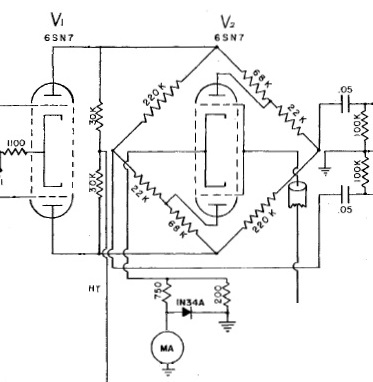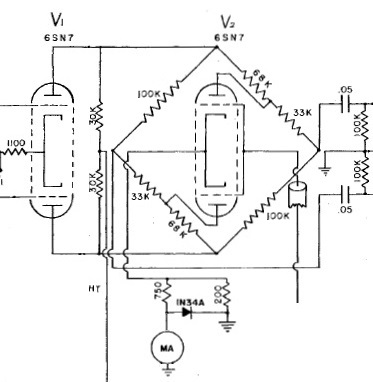Hello to all,
after finding this compressor in the Braunbuch, i have been wanting to build a version of it for months, and since i currently have no music to be recorded, I decided it might be a good time to finally get some of my ideas out of my head and into the studio.
This compressor is quite a simple circuit, with only two ECC81 double triodes as active amplifying parts, one for the make-up gain after the diode-bridge, and the other in the side-chain.
The diodes in the attenuator bridge are DS62 germanium diodes, which are equivalent to OA95 according to a equivalence chart i found online.
I think it would be really cool to fit this compressor onto a single 10x16cm Eurocard PCB, wich I think should be possible if the sidechain would be replaced by a solid state sidechain, which would get rid of a plate choke (the same as in the V72), a tube and the sidechain output transformer, also saving quite some money.
The power supply obviously has to be realized externally.
With that, it should not be to hard to get this thing on such a small PCB, even though there is still going to be quite some Iron on this thing: input transformer, interstage transformer, output transformer and plate choke.
Now i will have to figure out a way of building a solid state sidechain, and my first thought went to an op-amp for amplification followed by a drv134pa balanced line driver, since I have two of those laying around, and the output of the sidechain seems to be very similar to a line output stage.
The timing circuit after the sidechain output transformer could be used like it is, and maybe upgraded with a couple of various timing settings.
I would be very thankfull to hear your criticism and suggestions about this project, especially regarding the sidechain.
Best regards
Milan
after finding this compressor in the Braunbuch, i have been wanting to build a version of it for months, and since i currently have no music to be recorded, I decided it might be a good time to finally get some of my ideas out of my head and into the studio.
This compressor is quite a simple circuit, with only two ECC81 double triodes as active amplifying parts, one for the make-up gain after the diode-bridge, and the other in the side-chain.
The diodes in the attenuator bridge are DS62 germanium diodes, which are equivalent to OA95 according to a equivalence chart i found online.
I think it would be really cool to fit this compressor onto a single 10x16cm Eurocard PCB, wich I think should be possible if the sidechain would be replaced by a solid state sidechain, which would get rid of a plate choke (the same as in the V72), a tube and the sidechain output transformer, also saving quite some money.
The power supply obviously has to be realized externally.
With that, it should not be to hard to get this thing on such a small PCB, even though there is still going to be quite some Iron on this thing: input transformer, interstage transformer, output transformer and plate choke.
Now i will have to figure out a way of building a solid state sidechain, and my first thought went to an op-amp for amplification followed by a drv134pa balanced line driver, since I have two of those laying around, and the output of the sidechain seems to be very similar to a line output stage.
The timing circuit after the sidechain output transformer could be used like it is, and maybe upgraded with a couple of various timing settings.
I would be very thankfull to hear your criticism and suggestions about this project, especially regarding the sidechain.
Best regards
Milan
Last edited:




































